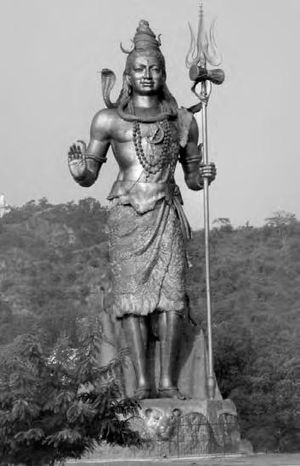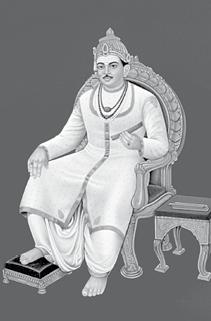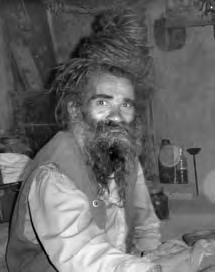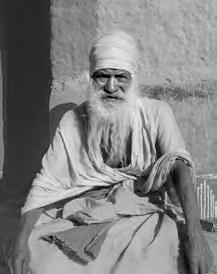Talk:Contemplative Practices in Saivism
Swami Tadananda
| ||||||
The excavations at Mohenjo-Daro and Harappa have revealed that the Śaiva religion is perhaps the most ancient faith in the world. Over the centuries, Śaivism developed many off-shoots and appeared in different forms in different parts of the world. In India, there are four main forms of this religio-philosophical movement: Vīraśaiva in South India (mainly Karnataka), Pāśupata in North India and Nepal, Advaita Śaivism in Kashmir, and the Śaiva-Siddhānta in Tamil Nadu. Furthermore, there are millions of devotees of Shiva all over the country who do not particularly subscribe to any of the above schools of Śaivism. Simple worship and devotion to Shiva characterizes their faith.
The various forms and practices of Śaivism have endowed it with the necessary vitality to survive and develop through the many centuries. It continues to be the vibrant and living faith of millions of people. Devotees of Lord Shiva range from those who hold on to Shiva with their simple faith and daily devotions, to earnest seekers of the highest Reality, who pursue the highly systematic doctrines and yogic practices of various branches of Śaivism.
Vīraśaiva[edit]
Vīraśaiva is a vibrant monotheistic faith, particularly prominent in its homeland—Karnataka. It was made popular by the Sri Basaveshvara (1105-67). The Vīraśaiva movement championed the cause of the downtrodden and evolved as a revolt against a system which fostered social inequality. Going against the way of the times, it rejected Vedic authority, caste hierarchy, the system of four stages of life, and veneration of a multiplicity of gods; the concepts of karmic bondage, existence of inner worlds, and the duality of God and soul; temple worship, ritualistic priest-craft, animal sacrifice, and the traditions of ritual purity-pollution.
To a Vīraśaiva, Shiva is the Supreme God, and he is to be worshiped through the linga. The linga is not an image of Shiva, but Shiva himself. It is described as a great mass of light shining before the eye. Shiva is the linga and the jiva is the anga (part); and the main purpose of Vīraśaiva worship is the search for and realization of the devotee’s divine oneness with Shiva through the linga. This is technically called lingānusandhāna, the internal penetration into Shiva through the worship and contemplation of the linga. It culminates in lingaikyatva when the anga or jiva becomes one with the Linga or the Supreme Shiva. To facilitate this union with and final absorption into the Deity, the Vīraśaiva takes recourse to Vīraśaiva initiation, astāvaranas or ‘eight aids to faith’, and the practice of the Sat-sthala Siddhānta philosophy described below.
Diksha (initiation), which opens the door and admits a person into the fold of Vīraśaivism, is considered essential and compulsory for attaining the final goal. It is simultaneous with lingadhārana or wearing of the linga. Hence the Vīraśaivas are also called Lingayats (bearers of the linga). Shiva resides in the disciple in the form of Consciousness or caitanya. It is believed that during the initiation ceremony the guru, through his spiritual power, extracts the caitanya existing in the body of the pupil and places it in the consecrated linga. The linga is worn encased in a pendant around the neck and worshiped throughout life. The linga must on no account be separated from the body, since such separation is equivalent to spiritual death. Vīraśaivism strongly condemns worship of Shiva in any form other than the istalinga (the personal linga). The guru also supplies the pupil with the eight emblems of faith which stand the devotee in good stead in his spiritual life. These eight aids to spiritual life are obedience to the guru, worship of the linga, reverence for the jangama or Vīraśaiva teachers, wearing of the sacred rudrāksa (rosary), use of the holy ash sacred to Shiva, partaking of the guru’s prasad, purification through holy water called tīrtha, and repetition of the six-lettered mantra Om Namah Śivāya, meaning ‘Obeisance to Shiva’. This mantra is to the Śaivas what Gayatri is to the Brahmanas. The Vīraśaivas do not accept any other mantra.
The philosophy of the Vīraśaivas is called the Sat-sthala Siddhānta. Its essence is the acceptance of the sat-sthalas, a progressive six-stage path of devotion and surrender, as the best means of achieving union with Shiva. Beginning with the acute realization of separation from God, the devotee passes through the stages of
- bhakta-sthala (devotion),
- maheśa-sthala (selfess service),
- prasādi-sthala (earnestly seeking Shiva’s grace),
- prānalingi-sthala (experience of all as Shiva), and
- śarana-sthala (egoless refuge in Shiva), and
- culminates in aikya-sthala (oneness with Shiva).
Each phase brings the seeker and Shiva closer, until they fuse together in a final state of perpetual Shiva-consciousness, as rivers merging in the ocean. It is insisted that in all these stages the istalinga must be worshiped, and that the istalinga must always serve as the basis of contemplation. A brief description of the sat-sthalas follows:
In the bhakta-sthala stage, the individual is offered the istalinga by his guru, who instructs him about the goal and the method of attaining it. The goal is unity with the Deity, which implies that the seeker is also akin to the Deity. Great emphasis is placed on devotional and ethical practices, which purify the soul of the impurities of egoism, passions, and destructive emotions. The devotee then rises to the maheśa-sthala, where he is in a joyful mood and is intent on serving others. The stage lays stress on firmness, courage, and staunch adherence to the Vīraśaiva dogmas. Observance of vows (vrata), regulations (niyama), and moral precepts (śīla); pure devotion, and freedom from desires enhance the purity of the soul. The devotee thus ascends to the prasādi-sthala, where the favour or grace (prasāda) of Shiva is bestowed upon him. He is now a prasādin and looks upon all objects as Shiva’s prasāda. Kriyā in the form of worship and jñāna are blended together from the beginning to the end. However, in the first three stages, worship gets an upper hand, and the distinction between the Deity and the devotee is maintained. In the next three stages, jnana predominates, and the distinction between Deity and devotee gradually decreases. In its place, the idea of the identity of the soul with the Deity emerges and becomes brighter. Through meditation, the devotee ascends to the prānalingi-sthala, where he realizes the Atman, the internal illuminating light of Consciousness (prāna means Atman here, and not vital force). The soul feels sure of its identity with the Deity, but due to the residual impressions of duality the identity is not complete. In the next stage, śarana-sthala, there is complete self-surrender to Shiva. The soul is in communion with the Deity, but duality still exists, though markedly attenuated. In the final stage, aikya-sthala, there is complete unity, and the soul ceases to exist as distinct from the Deity.
Vīraśaiva saints say that this final attainment is beyond what can be humanly expressed. It is only to be felt and experienced. The saint Renukacharya said, ‘Like water poured in water, fire placed in fire, the soul that becomes mingled in the Supreme Shiva is not seen as distinct.’
Pāśupata Śaivism[edit]
The Pāśupatas (from Paśupati, meaning Shiva, ‘the Lord of souls’) are the oldest known sect of Śaivite ascetic monks. Their most famous places of worship are the Somnāth Temple in Gujarat and the Paśupatināth Temple in Nepal. Pāśupatism is primarily an ascetic path that rejects dialectical logic and prizes sadhana as a means to actuate Lord Shiva’s compassionate grace (karunā), which is essential for liberation or dissociation from all sorrow.
Pāśupata monks follow a brave, ego-stripping path meant to infuse the seeker with Lord Shiva’s compassion. They wander about, pounding the dust with iron tridents and stout staffs, their oily hair snarled in unkempt coils or tied in a knot, and their loins wrapped in deerskin or coarse cloth. Their faces wrinkle with intense devotion and their piercing eyes see more Shiva than the world—which is permeated by Shiva. The holy ashes which besmear the body are indicators of the monk being a Pāśupata ascetic. Their chief mantra is Om Namah Śivāya. Their awe-inspiring austerity and worship of Shiva is steeped in a profound awareness of the cosmos as Shiva’s constant becoming, and is accompanied by an almost frolicsome spirit of devotion towards him.
In the beginning of their sadhana, the Pāśupatas practice special disciplines such as japa, Shiva-intoxicated laughter, singing, and dancing. These are accompanied with strict codes of ethics, called yama and niyama, stressing continence (brahmacharya), non-injury (ahimsa), non-irritability (akrodha), and asceticism (tapas). The next stage of sadhana is the performance of the pāśupata-vrata, which is a means of self-purification, of rooting out egoism, which is the fetter (pāśa) that estranges the soul (paśu) from its Lord (Paśupati). Pāśupatas believe that when a person is established in the path of asceticism, he is able to accept with equanimity all abuse and insult. Accordingly, the ascetics disperse into mainstream society and live incognito. There they purposely invite public censure by perpetrating outrageous acts such as making snorting sounds, babbling, walking as if crippled, gesturing wildly, and talking nonsense. Such behavior is meant not only to bestow fortitude but also to enliven the ascetic’s disinclination towards all worldly fame and honor. Thus they attempt to fully establish in their subconscious the knowledge that like and dislike, good and bad, and all such human ways of thinking and feeling are not different from one another if one’s love for Lord Shiva is sufficiently strong.
In the final stage, the seeker practices the Pāśupata-yoga, which enjoins the yogi to stay in a cemetery in order to intensify his renunciation without being subject to the attractions of the world; to have an ash-bath three times a day, to imitate the form of Shiva, and to dance, being intoxicated with devotion to him. He practices meditation by withdrawing his mind from all objects past, present and future—and devotedly concentrating it on Shiva. While meditating on Shiva, the aspirant should also meditate upon the Shakti of Shiva, as the whole world is pervaded by both of them. The ‘Vayaviya Samhita’ in the Shiva-maha-purana describes the Pāśupata-yoga as follows: The yogi is advised to sit still like a piece of stone and fix his attention on the tip of the nose. He should think of and meditate on Shiva and Shakti within himself, as if they were installed in the seat of the heart. Meditation should at first commence with an object; later on it becomes objectless[1]. Pāśupatas believe that since Shiva is formless (niskala), and unassociated with anything that can be expressed by speech (vāg-viśuddha), his formless nature should alone be meditated upon. Continuous meditation culminates in sāyujya, which means being in perpetual contact with Shiva. Liberation in Pāśupatism means duhkhānta, to be eternally disassociated from all sorrows.
Trika or Advaita School of Kashmir Śaivism[edit]
 According to Trika, Parama-Shiva, the Ultimate Reality, is not only universal Consciousness but also supreme spiritual Energy or Power. Its nature is described as prakāśa-vimarśamaya. Prakāśa is the eternal light of Consciousness. It is Shiva. Vimarśa is Shiva’s kartrtva śakti (power of action). She is so to speak, the mirror in which Shiva realizes his own grandeur, power and beauty. Shiva and his Shakti are non-different, just like fire and its burning power. The first two sutras of the Pratyabhijna-hridayam state that citi-śakti or Shiva’s ever-free creative power, of her own free-will, is the cause of the projection of the universe (Citih svatantra viśvasiddhi-hetuh). By the power of her own will, she unfolds the universe upon her screen, that is, in herself, the basis of the universe (Svecchayā svabhit-tau viśvam-unmīlayati).
According to Trika, Parama-Shiva, the Ultimate Reality, is not only universal Consciousness but also supreme spiritual Energy or Power. Its nature is described as prakāśa-vimarśamaya. Prakāśa is the eternal light of Consciousness. It is Shiva. Vimarśa is Shiva’s kartrtva śakti (power of action). She is so to speak, the mirror in which Shiva realizes his own grandeur, power and beauty. Shiva and his Shakti are non-different, just like fire and its burning power. The first two sutras of the Pratyabhijna-hridayam state that citi-śakti or Shiva’s ever-free creative power, of her own free-will, is the cause of the projection of the universe (Citih svatantra viśvasiddhi-hetuh). By the power of her own will, she unfolds the universe upon her screen, that is, in herself, the basis of the universe (Svecchayā svabhit-tau viśvam-unmīlayati).
Shiva veils or limits his true nature and powers by the maya of his Shakti and thus becomes bound as an empirical being or jiva. Maya has five coverings (kañcukas), which bring about this limitation of the universal Consciousness as follows:
- kalā reduces universal authorship (sarvakartrtva) to limited efficacy;
- vidyā reduces omniscience (sarvajñatva) to limited knowledge;
- rāga reduces ‘all-satisfaction’ (pūrnatva) and brings about desires for worldly objects;
- kāla reduces eternity (nityatva) to divisions in time—past, present, and future; and
- niyati reduces freedom and pervasiveness (svatantratā and vyāpakatva) and brings about limitation in respect of cause and space.
Thus Shiva forgets his universal divine nature and becomes jiva. In the course of this descent, the universal Consciousness-Power (citi-śakti) reduces herself into individual consciousness or citta.
The Trika philosophy recognizes that while Shakti is the cause of bondage, she is also the cause of and means to liberation. Sri Ramakrishna describes these two aspects of maya as avidyā-māyā and vidyā-māyā. He says further: ‘One must propitiate the Divine Mother, the Primal Energy, in order to obtain God’s grace. God Himself is Mahāmāyā, who deludes the world with Her illusion and conjures up the magic of creation, preservation, and destruction. She has spread this veil of ignorance before our eyes. We can go into the inner chamber only when She lets us pass through the door. Living outside, we see only outer objects, but not that Eternal Being, Existence-Knowledge-Bliss Absolute.’ The Vijnanabhairava also describes this Shakti as the doorway for entry into Shiva (Śaivī mukham iha ucyate).
Liberation in Trika means recognition (pratya-bhijñā) of one’s true divine nature as Shiva (mokso hi nāma naivānyah svarūpa-prathanam hi tat.) Sri Ramakrishna says much the same when he states that ‘man freed from bondage is Śiva; entangled in bondage, he is jiva’. Liberation from bondage comes by śaktipāta—the descent of divine Shakti—or anugraha, divine grace. By means of spiritual practices (sadhana), the individual consciousness (citta) is purifed and transformed into its orignal state of pure Consciousness, cit. To receive this grace, the aspirant has to undergo spiritual disciplines, which have been divided under four broad heads as means of approach (upāyas): ānavopāya, śāktopāya, śāmbhavopāya, and anupāya. These means of approach are to be adopted according to one’s progress up the spiritual ladder and are explained in detail in the Shiva-Sutras. They are briefly described here:
- In ānavopāya, the limited conditioned individual (anu) takes up some limited aspect such as buddhi (intellect), prāna (vital force), body, or some external object as support for the start of yogic practice. It is also called kriyopāya, since activities such as meditation (dhyana), repetition of the mantra (japa), worship of a chosen deity (puja), techniques of fixing attention on the various aspects of prāna—prāna, apāna, samāna, and the like—(prāna-dhāranā) are predominant. The Pātañjala-yoga corresponds to some aspects of ānavopāya.
- In śāktopāya, the aspirant resorts to the citi-śakti or vimarśa-śakti (the divine I-consciousness) for realization. It is also known as mantropāya or jñānopāya, and is prescribed for aspirants whose mind (citta) is already spiritually oriented. It is a process of self-inquiry in which the citta is used for seeking the source of its being, the significance of the mantra, and the supreme I-consciousness which is itself the source of all mantras. The ordinary mind is full of aśuddha vikalpas, impure or erroneous beliefs and ideas based on duality, which obstruct one’s true divine nature. Śāktopāya is the practice of śuddha vikalpa to nullify the sense of duality. Śuddha vikalpa is the idea and belief that ‘I am that unlimited Consciousness transcending all limited expressions of Reality. I alone am that highest Reality which is both transcendent to and immanent in the universe.’ It means pondering over that full, divine I-consciousness, which is the creative Shakti of the Supreme, as our true nature. The first sutra of śāktopāya in Shiva-Sutras states: cittam mantrah. Citta in this context is that which earnestly seeks to apprehend the highest Reality (cetyate vimrśyate anena parama-tattvam iti cittam). The mantra enshrines within itself the highest Reality, and awakens that mental awareness by which one feels one’s identity with this Reality. One thus saves oneself from the sense of separateness and difference characteristic of the world with the help of the mantra (mananāt trāyate iti mantra). Mantras consist of letters which are symbols of the creative shaktis of the Divine. The Parā-Śakti or Parā-Vāk or I-consciousness of the Supreme is the soul of all mantras. By constantly dwelling upon the significance of the real ‘I’ enshrined in the mantra, the citta ultimately becomes sanctified and transformed by the power of the mantra, and the aspirant attains prātibha jñāna or intuitive realization of the real divine Self. In Trika, this Self-realization is termed ātma-vyāpti (Self-awareness). The highest attainment, however, is called Śiva-vyāpti or Shiva-consciousness, in which the entire universe appears as I or Shiva. The jñāna-yoga of Vedanta corresponds somewhat to śāktopāya.
- Śāmbhavopāya is a special feature of the Śaiva tradition. It is meant for advanced aspirants who, by meditation on śivatattva (the Shiva principle), attain to his consciousness. It is the path of ‘constant awareness’. One starts with the practice of the consciousness that the universe is only a reflection of cit, but later on even this has to be given up. Malinivijaya describes Śāmbhava-yoga in the following way: ‘When there is identifcation with Shiva without any meditation or thought-process, but merely by an intensive orientation of will-power (icchā-śakti) towards the inner Reality, then there is Śāmbhava-yoga.’ When we neither accept, nor reject, when there is simple awareness freed from all ideation, then there is a sudden, spontaneous flash of experience of our essential Self. This is direct, immediate realization. Some contemplation techniques described in the Ashtavakra Samhita correspond to śāmbhavopāya.
- Anupāya can hardly be called an upāya. There are very advanced souls who receive this intense grace (tīvra śaktipāta). This anugraha or grace may come through just a word of the guru, or may be showered on them directly, and they experience Self-realization instantly. They are liberated without much spiritual practice.
The Pratyabhijnahridayam propounds that Shiva is ever engaged in the fivefold act (pañca-krtyas) of
- emanation (srsti),
- maintenance (sthiti),
- re-absorption (samhāra),
- concealment (vilaya), and
- grace (anugraha).
This fivefold act of Shiva continues even when he plays the role of an empirical self in bondage (Tathāpi tadvat pañcakrtyāni karoti). To be a bound soul (samsārin) is to be ignorant of one’s authorship of the fivefold act due to delusion by one’s own shaktis. Thus the Pratyabhijnahridayam lays the greatest stress on the contemplation of the pañca-krtyas that are going on constantly in the jiva. In order to rise to higher consciousness, the aspirant must constantly dwell on the esoteric meaning of the fivefold act as follows: The mental perception of the individual with reference to a particular place and time is srsti within. The retention and enjoyment of what one perceives is sthiti or preservation. At the time of the delight of I-consciousness, the object is absorbed in consciousness. This is samhāra. When, even after the object is withdrawn, its impression is about to rise in one’s consciousness again, that corresponds to vilaya (concealment of the real nature of the Self). When objective experience is completely absorbed into cit or the true Self, it is anugraha. By the constant practice of the awareness of this fivefold act and acquiring full knowledge of it, the citta (individual consciousness) by inward movement becomes citi (universal consciousness) by rising to the status of cetana (consciousness of the Self )—Tat parijñāne cittameva antarmukhī-bhāvena cetanapadādhyārohāt citih.
The Vijnanabhairava contains over a hundred dhāranās or contemplative practices, mainly for advanced aspirants.
Śaiva Siddhānta[edit]
Śaiva Siddhānta is a dualistic religion which is based on redemption through devotion and the grace (arul) of God. Through the experience of suffering and bondage in the world, a soul feels the necessity to come in contact with a higher power which can give it peace and solace. This is the stage when the soul is ripe for release from bondage (mala-paripāka), which qualifies it for the descent of divine grace (śaktinipāta). The soul awakens to the sense of divine Reality, Power, Glory, Beauty, and Grace, and begins to consciously struggle towards God, Shiva, by gradually renouncing its entanglement with the world and engaging itself in spiritual discipline. According to the intensity of the śaktinipāta, the religious life of the devotee is divided into four stages: caryā, kriyā, yoga, and jñāna, each with specific physical and mental activities prescribed for cultivation of devotion.
Caryā and kriyā are the beginner’s stages of purification of the mind. Caryā, which is fully external, includes worship of God with the aid of temples and images, and service to God’s devotees as well as to all beings. It includes easy duties such as lighting lamps, plucking flowers, sweeping and washing the temple, praising God, cooking food offerings, and assisting in his worship. Kriyā is both external and internal in form and method. It comprises performing puja, reading and learning the scriptures, reciting prayers, japa, meditation, austerities, truthfulness, purity, love, and offering food. Yoga is a purely psychological process of purifying the mind and body through the control of the organs of action and knowledge, through pranayama, and through contemplation and meditation on God and his infinite attributes. When the devotee is well established in the above three stages, God appears in the form of a guru to direct and guide him or her into the mysteries of jñāna sādhanā (or sanmārga, the way of truth), through which the devotee endeavors to attain final union with Shiva.
The practice of jñāna sādhanā is divided into three stages, which are again subdivided into ten states called daśakārya. The first stage consists of tattva-rūpa, tattva-darśana, and tattva-śuddhi. Through these, the devotee attains a true knowledge of the tattvas (categories of nature) and realizes that they are products of maya, which is material, insentient, and impure. This knowledge confers the strength to cut asunder the binding infuence of maya. The second stage consists of ātma-rūpa,ātma-darśana, and ātma-śuddhi, through which the soul disengages itself from the control of the tattvas, realizes itself as pure and free intelligence, and identifies itself with the divine grace of God (arul-śakti). The third stage consists of the states of śiva-rūpa, śiva-darśana, śiva-yoga, and śiva-bhoga. In śiva-rupa, the devotee attains the knowledge that the omnipresent Supreme Shiva, with the help of Parā-Śakti, is engaged in the five acts of creation, preservation, concealment, destruction, and bestowal of grace. In śiva-darśana, the purifed soul, freed from I-ness and my-ness, sees Shiva in everybody and everywhere and enjoys supreme bliss. The state of union in which the soul completely identifies itself with Shiva and sees that all activities and actions, both individual and of the world, flow from Shiva, is śiva-yoga. Śiva-bhoga is the state of liberation called jivanmukti. The soul is finally cleansed of all its impurities and dwells in Shiva, and Shiva dwells in it. It enjoys the supreme Bliss (śivānanda) which is beyond any subject-object relationship. In the Śaiva Siddhānta philosophy of liberation, the individuality of the soul is not annihilated, but the soul completely identifies itself with Shiva and appears as One. The Śaiva saint Arunagirinathar sings: ‘That which neither goes nor comes, which knows neither night nor day, which is neither without nor within, which is speechless and formless and without end, assails me ceaselessly and makes me Itself, conferring tranquility of mind. The blissful state is beyond expression, O Lord of six aspects!’
References[edit]
- ↑ ‘Vayaviya Samhita’, Shiva-maha-purana, 7.2.38
- Originally published as "Contemplative Practices in Saivism" by Prabhuddha Bharata January 2007 edition
. Reprinted with permission.





